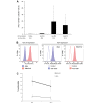Targeting cryptic epitope with modified antigen coupled to the surface of liposomes induces strong antitumor CD8 T-cell immune responses in vivo
- PMID: 26398429
- PMCID: PMC4722887
- DOI: 10.3892/or.2015.4299
Targeting cryptic epitope with modified antigen coupled to the surface of liposomes induces strong antitumor CD8 T-cell immune responses in vivo
Abstract
Active cancer immunotherapy, such as cancer vaccine, is based on the fundamental knowledge that tumor‑associated antigens (TAAs) are presented on MHC molecules for recognition by specific T cells. However, most TAAs are self-antigens and are also expressed on normal tissues, including the thymus. This fact raises the issue of the tolerance of the TAA‑specific T‑cell repertoire and consequently the inability to trigger a strong and efficient antitumor immune response. In the present study, we used antigens chemically coupled to the surface of liposomes to target telomerase reverse transcriptase (TERT), a widely expressed self/tumor antigen. Taking advantage of the high homology between mouse and human TERT, we investigated immunogenicity and antitumor efficiency of the liposomal TERT peptides in HLA-A*0201 transgenic HHD mice. Using the heteroclitical peptide-modifying approach with antigen‑coupled liposomes, we identified a novel cryptic epitope with low affinity for HLA*0201 molecules derived from TERT. The heteroclitical variant derived from this novel low affinity peptide exhibited strong affinity for HLA*0201 molecules. However, it induced only weak CD8 T‑cell immune responses in HHD mice when emulsified in IFA. By contrast, when coupled to the surface of the liposomes, it induced powerful CD8 T‑cell immune responses which cross-reacted against the original cryptic epitope. The induced CD8 T cells also recognized endogenously TERT‑expressing tumor cells and inhibited their growth in HHD mice. These data suggest that heteroclitical antigen derived from low affinity epitope of tumor antigens coupled to the surface of liposome may have a role as an effective cancer vaccine candidate.
Figures





Similar articles
-
CpG oligodeoxynucleotides activate dendritic cells in vivo and induce a functional and protective vaccine immunity against a TERT derived modified cryptic MHC class I-restricted epitope.Vaccine. 2006 Mar 10;24(11):1880-8. doi: 10.1016/j.vaccine.2005.10.036. Epub 2005 Oct 28. Vaccine. 2006. PMID: 16300869
-
A modified epitope identified for generation and monitoring of PSA-specific T cells in patients on early phases of PSA-based immunotherapeutic protocols.Vaccine. 2009 Mar 4;27(10):1557-65. doi: 10.1016/j.vaccine.2009.01.011. Epub 2009 Jan 24. Vaccine. 2009. PMID: 19171173
-
High vaccination efficiency of low-affinity epitopes in antitumor immunotherapy.J Clin Invest. 2004 Feb;113(3):425-33. doi: 10.1172/JCI19418. J Clin Invest. 2004. PMID: 14755339 Free PMC article.
-
The immunogenicity of the hTERT540-548 peptide in cancer.Clin Cancer Res. 2008 Jan 1;14(1):4-7. doi: 10.1158/1078-0432.CCR-07-4590. Clin Cancer Res. 2008. PMID: 18172245 Review.
-
TEIPP antigens for T-cell based immunotherapy of immune-edited HLA class Ilow cancers.Mol Immunol. 2019 Sep;113:43-49. doi: 10.1016/j.molimm.2018.03.029. Epub 2018 Apr 4. Mol Immunol. 2019. PMID: 29627136 Review.
Cited by
-
Structural effects and lymphocyte activation properties of self-assembled polysaccharide nanogels for effective antigen delivery.Sci Rep. 2018 Nov 7;8(1):16464. doi: 10.1038/s41598-018-34885-8. Sci Rep. 2018. PMID: 30405172 Free PMC article.
References
-
- Kawakami Y, Eliyahu S, Delgado CH, Robbins PF, Sakaguchi K, Appella E, Yannelli JR, Adema GJ, Miki T, Rosenberg SA. Identification of a human melanoma antigen recognized by tumor-infiltrating lymphocytes associated with in vivo tumor rejection. Proc Natl Acad Sci USA. 1994;91:6458–6462. doi: 10.1073/pnas.91.14.6458. - DOI - PMC - PubMed
-
- Taneichi M, Ishida H, Kajino K, Ogasawara K, Tanaka Y, Kasai M, Mori M, Nishida M, Yamamura H, Mizuguchi J, et al. Antigen chemically coupled to the surface of liposomes are cross-presented to CD8+ T cells and induce potent antitumor immunity. J Immunol. 2006;177:2324–2330. doi: 10.4049/jimmunol.177.4.2324. - DOI - PubMed
Publication types
MeSH terms
Substances
LinkOut - more resources
Full Text Sources
Other Literature Sources
Molecular Biology Databases
Research Materials

